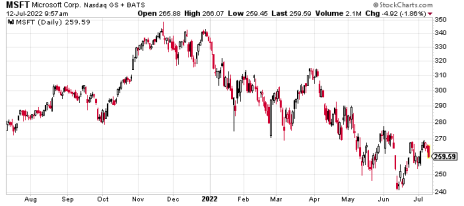Each week in my Quant Trader and Income Trader advisories I send out my updated High-Probability Mean Reversion Indicator which includes roughly 25-35 highly liquid ETFs and stocks.
The list contains the overbought/oversold levels of each security as well as the current implied volatility and IV rank. As I’ve explained in the past, there are numerous strategies that we can use when a highly liquid ETF hits an overbought or oversold state.
Today, I want to focus on a strategy I like to use on oversold stocks.
Our Oversold Stock: Microsoft (MSFT)
As the name of the strategy implies, a bull put spread is a bullish-leaning strategy.
[text_ad use_post='262600']
But it is important to note that the strategy doesn’t require the security to move higher to make money. Unlike the binary nature of stock strategies, a stock can either go up or down with a bull put spread. So, you not only have the ability to make a return when a security moves higher, you can also make money if the stock stays flat or even if the stock pushes slightly lower.
Let’s examine this strategy with one particularly oversold stock: Microsoft (MSFT).
With MSFT now trading for 259.59 I want to look at a potential short-term bull put spread going out around 30-50 days.
My intent is to take off the trade well before the August 19, 2022, expiration date. For this bullish spread example, my preference is to go with a trade that has around an 80% to 85% probability of success.
As always, let’s start by taking a look at the various expiration cycles for MSFT going out around 30-50 days until expiration.
Once we choose our expiration cycle (it will differ in duration depending on outlook, strategy and risk), we begin the process of looking for a put strike within the August 19 expiration cycle that has around an 80% probability of success.
If you don’t have access to probabilities of success on your trading platform look towards the delta. Without going into too much detail, look for a put strike that has a delta around 0.15 to 0.20, as seen below.
Since we are focused on using a bull put spread, we only care about the upside risk at the moment.
The 225 put strike, with an 81.77% probability of success, works. It’s just inside the expected range, but we can adjust accordingly if needed. I want to have an opportunity to bring in 13.6% over the next 38 days, while keeping my probability of success at the onset of the trade to around 80% or higher.
The short 225 put strike defines my probability of success on the trade. It also helps to define my overall premium, or return, on the trade. Basically, as long as MSFT stays above the 225 put strike at the August expiration in 38 days we will make a max profit on the trade. But, as I stated before, my preference is to take off profits early and, in most cases, reestablish a position if warranted, much like I have over the past several months.
Also, time decay works in our favor on the trade, so as we get closer and closer to expiration our premium will erode at an accelerated rate. As a result, we should have the opportunity to take the bull put spread off for a nice profit prior to expiration–unless, of course, MSFT plummets to the downside over the next 38 days. But still, that doesn’t hide the fact that with this trade we can be completely wrong in our directional assumption and still make a max profit.
Once I’ve chosen my short put strike, in this case the 225 put, I then proceed to look at the other half of a 3-strike wide, 4-strike wide and 5-strike wide spread to buy.
The spread width of our bull put defines our risk/capital on the trade.
The smaller the width of our bull put spread the less capital required, and vice versa for a wider bull put spread.
When defining your position size, knowing the overall defined risk per trade is essential. Basically, my premium increases as my chosen spread width increases.
Bull Put Spread: August 19, 2022, 225/220 Bull Put Spread or Short Vertical Put Spread
Now that we have chosen our spread, we can execute the trade.
Simultaneously:
Sell to open MSFT August 19, 2022, 225 put strike
Buy to open MSFT August 19, 2022, 220 put strike for a total net credit of roughly $0.60, or $60 per bull put spread.
- Probability of Success: 81.77%
- Total net credit: $0.60, or $60 per bull put spread
- Total risk per spread: $4.40, or $440 per bull put spread
- Max Potential Return: 13.6%
Again, as long as MSFT stays above our 225 put strike at expiration in 38 days, I have the potential to make a max profit of 13.6% on the trade. In most cases, I will make less, as the prudent move is to buy back the bull put spread prior to expiration.
Again, I look to buy back a spread when I can lock in 50% to 75% of the original credit. Since we sold the spread for $0.60, I would look to buy it back when the price of my spread hits roughly $0.30 to $0.15, if not less.
Of course, there are a variety of factors to consider with each trade. And we allow the probabilities and time to expiration to lead the way for our decisions. But, taking off risk, or at least half the risk, by locking in profits is never a bad decision, and by doing so we can take advantage of other opportunities the market has to offer.
Risk Management
Since we know how much we stand to make and lose prior to order entry we can precisely define our position size on every trade we place. Position size is the most important factor when managing risk, so keeping each trade at a reasonable level (I use 1% to 5% per trade) allows not only the Law of Large Numbers to work in your favor … it also allows you to sleep well at night.
I also tend to set a stop-loss that sits 1 to 2 times my original credit. Since I’m selling the 225/220 bull put spread for $0.60, if my bull put spread reaches approximately $1.20 to $1.80, I will exit the trade.
As always, if you have any questions, please do not hesitate to email me or post a question in the comments section below. And don’t forget to sign up for my Free Newsletter for education, research and trade ideas.
[author_ad]


